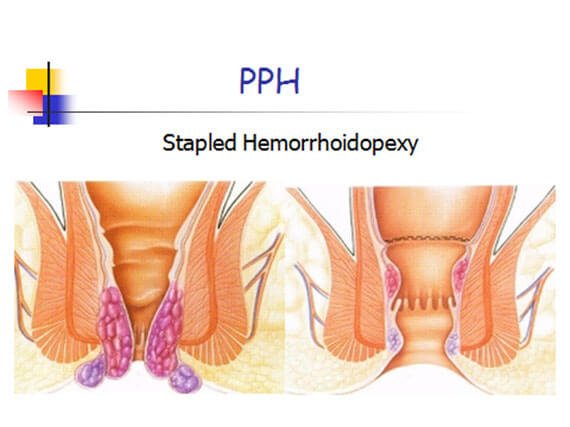HEMORRHOIDS:
DIAGNOSIS AND TREATMENT
Patients often contact our office seeking care for "hemorrhoids"; you may be surprised to learn, however, that only a small percentage of these complaints are actually due to hemorrhoids. A wide range of conditions, including fissures, fistula abscesses, infections, and even cancer can produce similar symptoms. The most frequent of these symptoms are bleeding and rectal pain; mucus leakage, difficulty cleaning after a bowel movement, and anal itching or irritation may also occur. The cause of hemorrhoids has been attributed to prolonged periods of driving, sitting on cold seats or benches, eating spicy foods, and doing manual labor, though these activities are rarely the cause of anal problems.
There are two types of hemorrhoids:
External hemorrhoids. Located just outside the anal canal, these can become swollen and painful (thrombosed).
Internal hemorrhoids. Located inside the anal canal, these are relatively specific, and manifest in bright red bleeding or prolapsing anal tissue.
The standard classification of hemorrhoids consists of four grades, which describe what is happening to the internal hemorrhoids.
- Grade 1 hemorrhoids: these cause bleeding, but do not prolapse.
- Grade 2 hemorrhoids: these cause bleeding and also prolapse outside of the anus at the time of bowel movement. The hemorrhoidal tissue, however, spontaneously returns back into the anal canal after a bowel movement.
- Grade 3 hemorrhoids: these cause bleeding and prolapse, but remain outside the anal canal until they are manually pushed back inside.
- Grade 4 hemorrhoids: in this case, internal hemorrhoids sit outside the anus; they re-prolapse even after being pushed back inside.
All Grades may be associated with external skin tags; in most cases, the higher the grade, the more associated tagging.
Since straining to have a bowel movement, excessively frequent loose stools, and/or sitting for prolonged periods/reading on the commode can be an inciting cause of many hemorrhoidal symptoms, the careful use of fiber and stool softeners may help alleviate many symptoms. Itching can often be relieved by avoiding the use of soap on the perianal skin, as well as limiting coffee and other hot caffeinated beverages. Several over-the-counter creams or ointments may often soothe the hemorrhoids.
After confirming that the diagnosis is in fact hemorrhoids, we treat the vast majority of our patients in our office without surgery. Painful or bleeding thrombosed external hemorrhoids can often be completely removed in our office, with the use of a local anesthetic.
One method of treatment for Grade 1 internal hemorrhoids is medical management. Another is infrared coagulation, which is used for both Grade 1 and occasionally Grade 2 hemorrhoids. We believe it is less successful than rubber band ligation (which involves tying off the hemorrhoids) for most Grade 2 cases, because it requires a greater number of treatments, as well as longer administration time for each treatment.
For Grade 2 and Grade 3 hemorrhoids, we typically employ rubber band ligation treatment; it takes just seconds and is relatively painless. Rubber band ligation usually involves one to three treatments in the office.
We typically recommend a hemorrhoidectomy for Grade 4 hemorrhoids, or for Grade 3 hemorrhoids featuring a large external tag. This surgery involves removing the prolapsing internal hemorrhoid and the external tag component. This treatment has a high rate of success; patients generally experience full resolution of symptoms, without relapse.
Patients experience discomfort following surgery, because the low rectum and anal canal are very sensitive areas. Depending upon the extensiveness of the surgery, a patient may miss one to two weeks of work. A common question regarding surgical management of hemorrhoids involves laser treatment. Our practice has not used this for many years; our experience and that of others published in the literature show that laser treatment for hemorrhoids actually leads to more post-operative pain and swelling than standard hemorrhoidectomy treatment.
PPH is a more minimally invasive surgical approach; it involves resuspending hemorrhoidal tissue to its original anatomic position, using a circular stapling instrument. This procedure also reduces the blood flow to the internal and external hemorrhoids; this eventually causes the hemorrhoids to shrink in size, relieving preoperative symptoms. The PPH results in less pain and a quicker recovery than traditional hemorrhoid surgery, because it is performed above the level where nerves end inside the anal canal. This procedure allows patients to be more active after their surgery, and also allows the patient to return to work in only a few days.
All of the physicians here at Colon Rectal Surgical Associates are experienced in PPH surgery, and offer it as an alternative for those requiring hemorrhoidectomy. This procedure is especially effective for those patients on blood thinning medications such as Coumadin.

